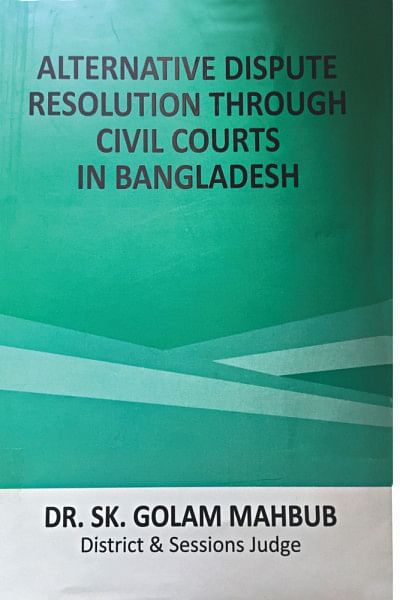Alternative Dispute Resolution and justice in civil courts

Alternative Dispute Resolution (ADR) through civil courts in Bangladesh is a painstaking appraisal of court-based ADR regarding civil disputes in the context of Bangladesh. The primary object of the book is to deal with the ADR system that operates in Bangladesh in reducing the huge backlog of cases currently subsisting in our judiciary. That the book is greatly influenced by the author’s (a District and Session Judge, currently serving as a Deputy Secretary-01 (Administration) at the Ministry of Law, Justice and Parliamentary Affairs) doctoral research eventually offering an empirical work on the topic, is the most treasurable contraption about the book.
First, second, and third chapters are designed for the researchers and academics; in those chapters, the author has elaborated the framework of his research (by giving an outline to the disputes worthy of being compromised) and set out to capture systematically the dynamic contours of the historical evolution of ADR into our current legal system.
Any searching for academic discussion on ADR can directly start from chapter four. Different forms of ADR mechanisms along with the basic concepts and limitations of those mechanisms have been critically dissected in this chapter. How traditional approach of adversarial system gives birth to more litigation instead of reducing them has also been explained profoundly in this chapter.
Chapter five explains the basic concept of court-based ADR and illustrates various existing forms of court-based ADR in Bangladesh. A healthy review of the existing ADR laws on Civil, Family, Artha Rin (Money Loan) and Tax matters have also been made. While reviewing the ADR provisions, the chapter attempts to assess the existing proposition of the court-based ADR and its efficacy in settling disputes in accord with the quasi-formal ADR system.
Comparative analysis of ADR mechanism in different countries and applicability issues are the topics of chapter six. The prime effort of this chapter is to weigh whether we can adopt those foreign experiences into our legal arena.
The existing court-based ADR systems accompanied by its demerits have been discussed in chapter seven. For assessing the efficiency of current ADR system, the author puts his primary data collected during field study and responses of different stakeholders of the ADR process in action which strengthens the study to a remarkable extent. The outcome of the field study has been presented in this chapter through different figures, bar graphs, line graphs and charts. The prospects and problem of the current court-based ADR system and solutions to the same provided at the end of this chapter will definitely be gobbled by the researches and academics.
In chapter eight, the author has critically analysed the ‘auto-applicability of ADR system’ – which has been brought to the Code of Civil Procedure in 2012 by an amendment to all kinds of suits. Not all the suits are suitable for disposal through the ADR system, owing to which most of the referred disputes are found to be unsuccessful. A filtering system of the suits regarding its nature and characteristics from which only ADR-open disputes would be referred to the court could serve the purpose. Engaging more legal aid officers in resolving disputes docile to the alternative solutions, in the author’s opinion, could be a feasible method to put a halt to the overflow of civil suits to the civil courts as well. The author has also emphasised on the cooperative role of the lawyers and NGOs to make court-based ADR process a success. These valuable findings came in the form of suggestion and recommendations under this chapter.
This book, authored by a person who is a judge, academic and an independent researcher, offers a touch for every section of targeted readers, e.g. researchers, academicians, students, and policymakers etc. But while the author’s endeavour is on the whole well-written and the book itself is attractively designed and produced, it could have been somewhat shorter and less costly. Nevertheless, this is an important book for researchers, academics, students of law, lawyers, trainers and litigants seriously interested in court based ADR system regarding civil disputes in Bangladesh will find well worth reading and keeping in their bookshelves.
The reviewer is a member of Bangladesh Judicial services.

 For all latest news, follow The Daily Star's Google News channel.
For all latest news, follow The Daily Star's Google News channel. 



Comments